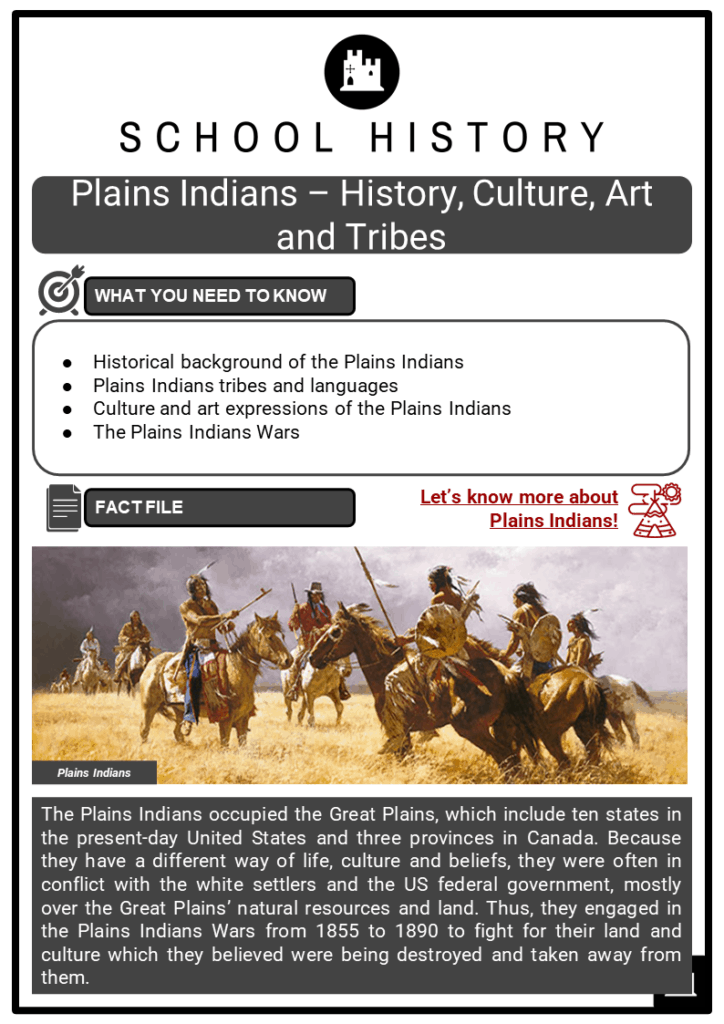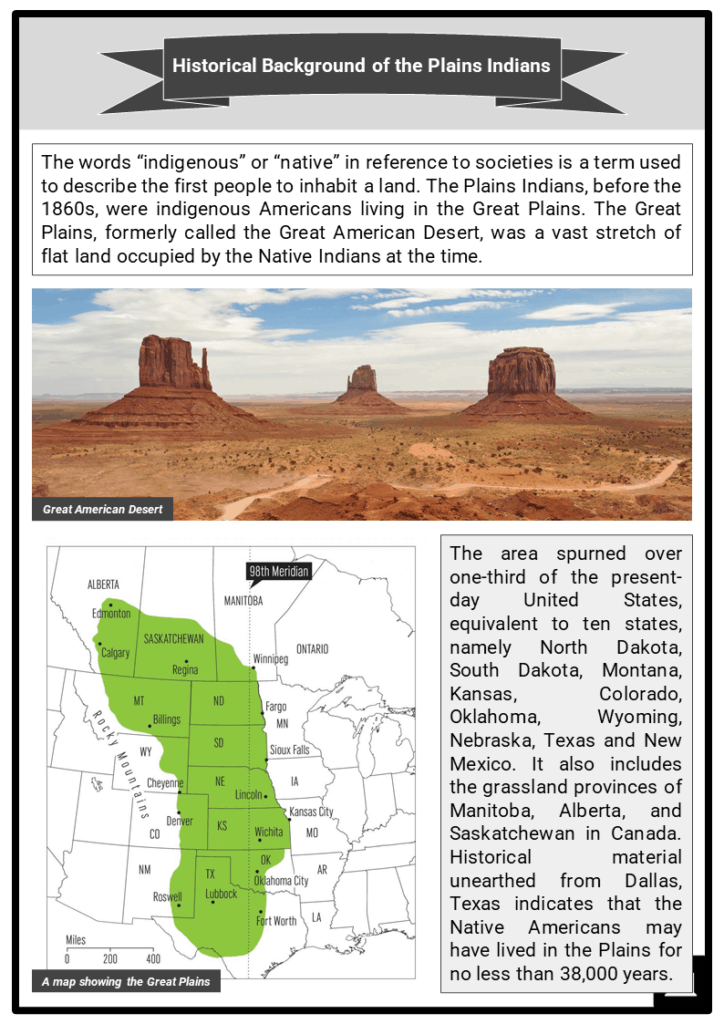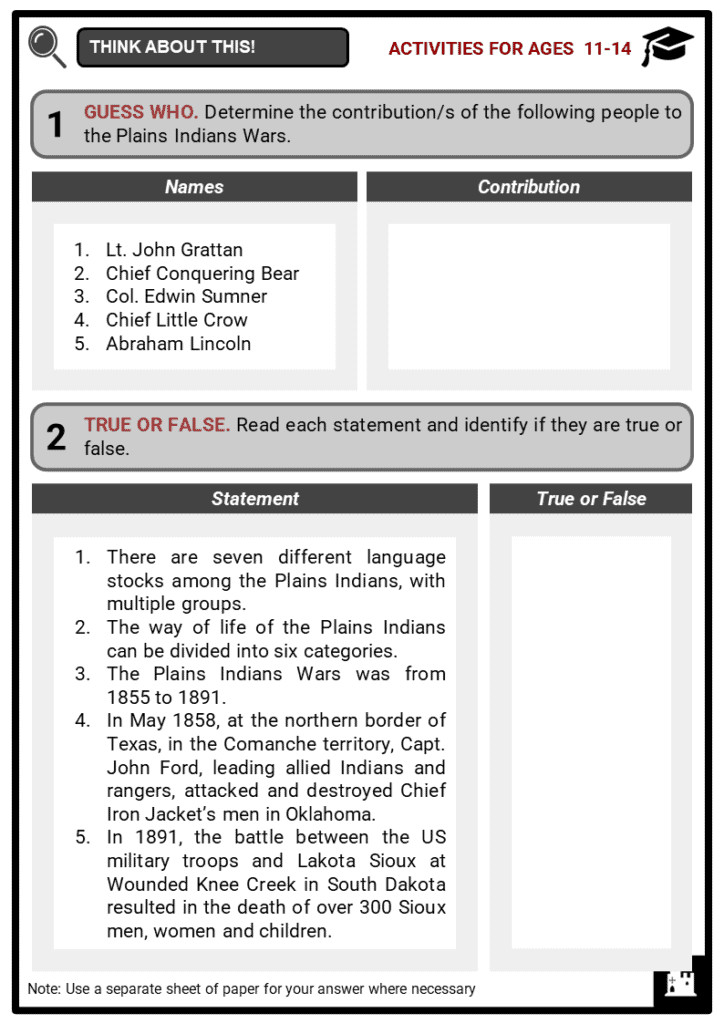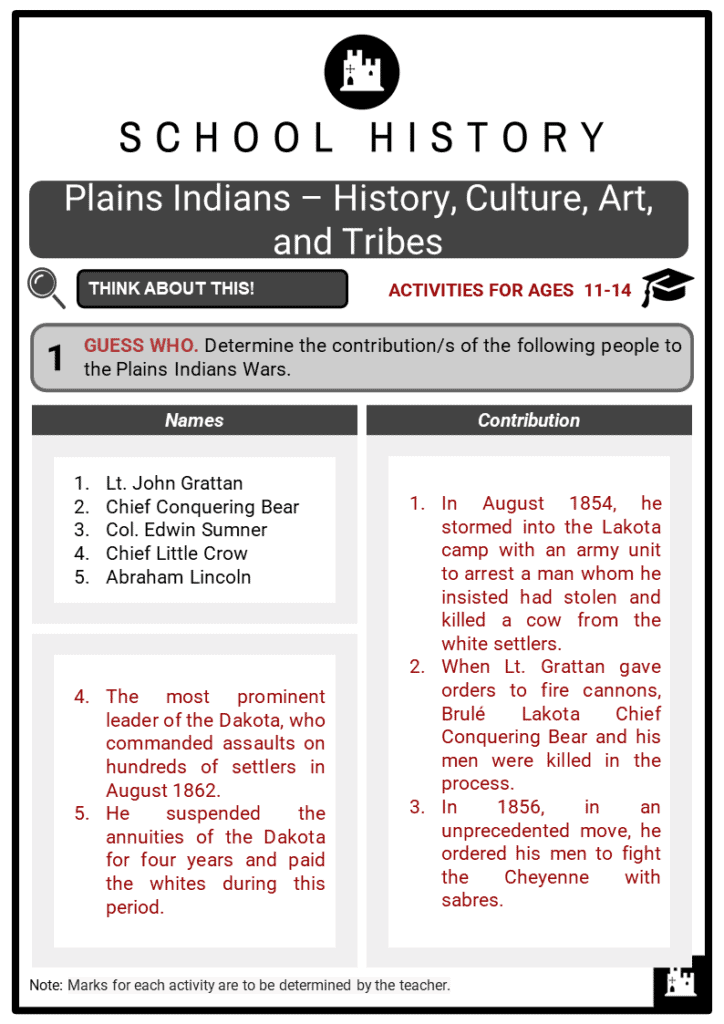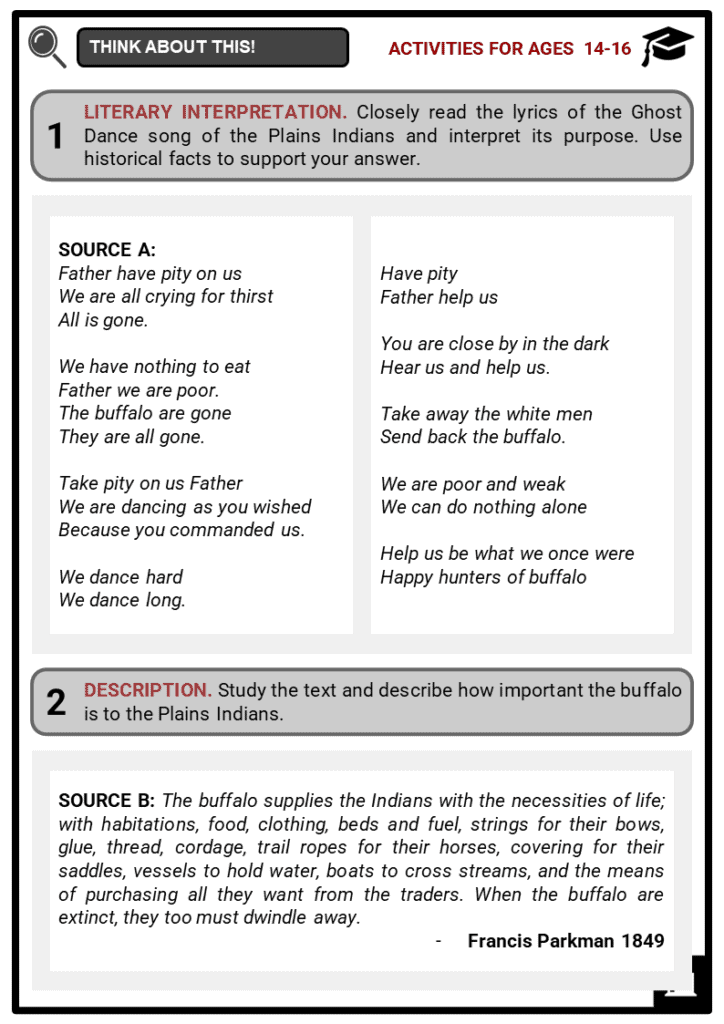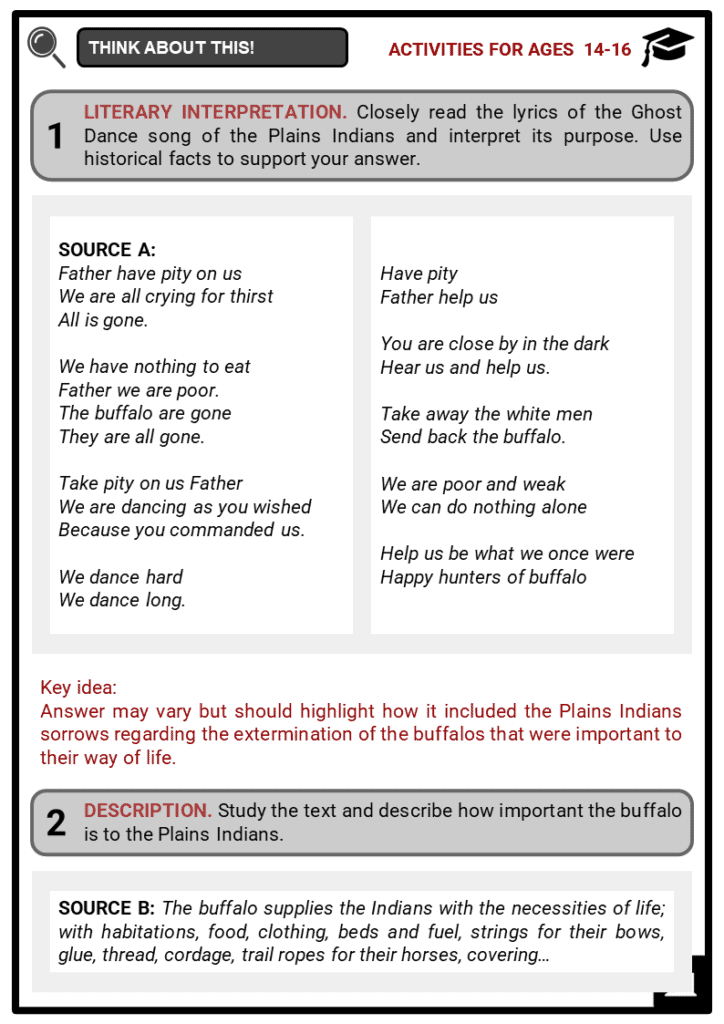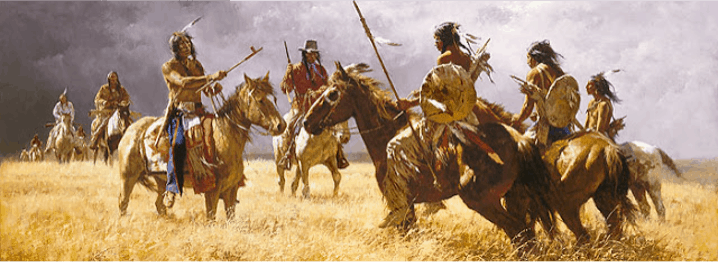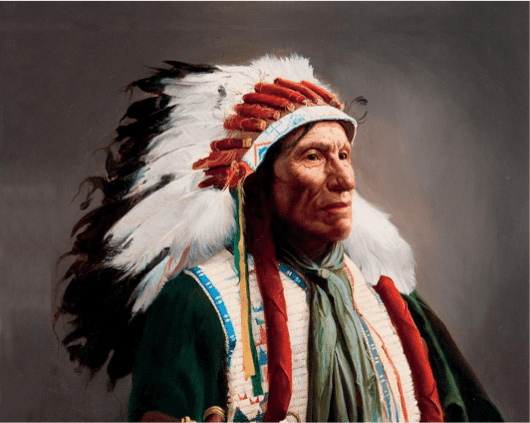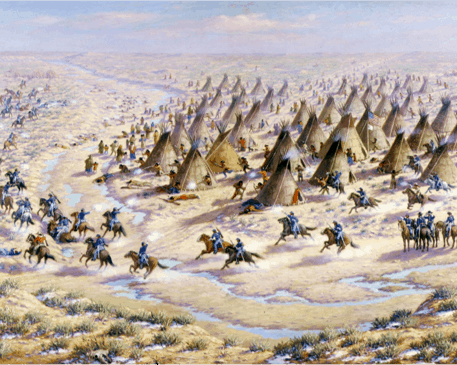Download Plains Indians – History, Culture, Art and Tribes Worksheets
Do you want to save dozens of hours in time? Get your evenings and weekends back? Be able to teach Plains Indians – History, Culture, Art and Tribes to your students?
Our worksheet bundle includes a fact file and printable worksheets and student activities. Perfect for both the classroom and homeschooling!
Table of Contents
Add a header to begin generating the table of contents
Summary
- Historical background of the Plains Indians
- Plains Indians tribes and languages
- Culture and art expressions of the Plains Indians
- The Plains Indians Wars
Key Facts And Information
Let’s know more about Plains Indians!
- The Plains Indians occupied the Great Plains, which include ten states in the present-day United States and three provinces in Canada. Because they have a different way of life, culture and beliefs, they were often in conflict with the white settlers and the US federal government, mostly over the Great Plains’ natural resources and land. Thus, they engaged in the Plains Indians Wars from 1855 to 1890 to fight for their land and culture which they believed were being destroyed and taken away from them.
Historical Background of the Plains Indians
- The words “indigenous” or “native” in reference to societies is a term used to describe the first people to inhabit a land. The Plains Indians, before the 1860s, were indigenous Americans living in the Great Plains. The Great Plains, formerly called the Great American Desert, was a vast stretch of flat land occupied by the Native Indians at the time.
- The area spurned over one-third of the present-day United States, equivalent to ten states, namely North Dakota, South Dakota, Montana, Kansas, Colorado, Oklahoma, Wyoming, Nebraska, Texas and New Mexico. It also includes the grassland provinces of Manitoba, Alberta, and Saskatchewan in Canada. Historical material unearthed from Dallas, Texas indicates that the Native Americans may have lived in the Plains for no less than 38,000 years.
- There are six different language stocks among the Plains Indians, with multiple groups:
- Algonquian
- The first is the Algonquian language speakers. They included the Arapaho, Atsina, Blackfoot, Plains Cree and Plains Ojibwa of the Northern Plains and the Cheyenne of the Central Plains.
- Siouan
- The second is the Siouan languages, which included the Crow, Mandan, Assiniboine, Omaha, Hidatsa, Osage, Kansa, Oto, Iowa, Ponca and Missouri.
- Uto-Aztecan and Caddoan
- The Wind River Shoshone and the Comanche groups belonged to the Uto-Aztecan language stock while the Caddoan stock included the Pawnee, Arikara and Wichita.
- Athabaskan and Kiowa-Toan
- The Athabaskan stock had the Sarcee group in the Northern Plains, and the Kiowa group represented the Kiowa-Toan stock.
- Lastly, the Plains Indians Sign Language is an additional language used among Plains Indians with different spoken languages.
Culture and Art Expressions of the Plains Indians
- The way of life of the Plains Indians can be divided into two categories: the nomadic hunters, who moved around following the buffalo migration, and semi-sedentary tribes, who were buffalo hunters and farmers.
- The nomadic tribes were the Arapaho, Blackfoot, Cheyenne, Crow, Comanche, Assiniboine, Gros Ventre, Sioux and Shoshone to mention but a few. They followed the seasonal migration of buffaloes. The Mandan, Osage, Omaha, Otoe, Pawnee, Iowa, Kansa and Hidatsa lived a semi-sedentary way of life.
- The Arapaho and Cheyenne were initially sedentary people, focusing on agriculture, but when they discovered the horse from the white settlers, they adapted into a nomadic lifestyle, raiding the horses of the Pawnee and Comanche.
- The Plains Indians had a common culture and art expressions. They lived in semi-permanent structures called teepees (tipis). The teepees were long cone-shaped and made with long wooden poles used as frames and covered with buffalo hide.
- The Plains Indians used buffalo dung as fuel for fire for warmth in the night and over winter. They used buffalo’s intestine and bladder as food bags, cooking vessels and buckets. Unlike pots, which were heavy and easy to break, the intestines and bladder were durable and light to carry around owing to the nomadic nature of their lifestyle.
- Plains Indians were also fierce warriors. The Sioux tribe is considered the most violent of all the tribes and the most resistant to the European invasion of their land. In warfare, the Plains Indians warriors would cut off the scalps of their dead enemies to achieve honour. At times, they would tap an enemy with a stick in battle, rather than kill. A strategy they called ‘counting coup.’
- The Plains Indians’ beliefs about land and nature are different from other societies. One example is their belief of the Spirit World. Wakan Tanka or the Great Spirit was very significant to them, as he created the world and all life forms on Earth. They also believed that all living things had spirits and it had influence over their lives as a whole.
- They also had different dances and ritual ceremonies which were ways for them to contact the spirit world. These included buffalo and scalp dances. The Sundance was the most famous when bands came together.
- Another belief of theirs was the visions that helped them in their journey. This was another way for them to contact the spirits. Young men were asked to search for theirs through cleaning their body, praying and fasting. For women, they developed visions once they reached puberty.
- Lastly, the Plains Indians had a different belief about land and it was one that was the most misunderstood and would later cause tension with the US army. They believed that land was part of life itself and some of it was considered to be sacred. Land could not be owned by any individual.
The Plains Indians Wars
- The extended conflicts between the Native American Indians, the federal government, and the white settlers over the Great Plains’ natural resources and land from 1855 to 1890 was called the Plains Indians Wars.
- In 1851, representatives from the Sioux, Arapaho, Cheyenne, Crow, Assiniboine, Hidatsa, Ankara and Mandan entered into a treaty with the United States federal government. The agreement outlined the territorial claims as among the groups, and the US recognised the land covered in the accord as Indian Territory. Further, Natives guaranteed the settlers passage along the Oregon Trail and, for an annuity of fifty thousand dollars for fifty years, allowed roads and forts to be built in their territories.
- In August 1854, a cow escaped into the Sioux (Lakota) camp and Lt. John Grattan, upon receiving reports from the settlers that the cow was stolen, stormed into the village with an army unit to arrest a man whom he insisted had killed the cow. The man, asserting his innocence, refused the arrest. Lt. Grattan then gave orders to fire cannons and in the process, Chief Conquering Bear, a Brulé Lakota chief, and his men were killed.
- In anger, the Sioux killed Lt. Grattan and his party. In September 1855, General Williams took 600 troops to retaliate against the Natives, killing 85 of them and taking 70 women as captives. In the following year, the Natives engaged the federal government army and the settlers in open war and raids.
- In 1856, Col. Edwin Sumner encountered an eager Cheyenne ready to engage in battle with the assurance of the safety of magical waters. Sumner, in an unprecedented move, ordered his men to fight with sabres, making the Cheyenne flee in confusion because the magical waters did not protect them from the steel blades. There was relative peace in the central plains for a while after the incident.
- In May 1858, at the northern border of Texas, in the Comanche territory, Capt. John Ford, leading allied Indians and rangers, attacked and destroyed Chief Iron Jacket’s men in Oklahoma. In October, General Earl Van Dorn attacked Chief Buffalo Hump’s camp in Rush Spring and killed one hundred Comanche. The Comanche executed numerous raids against the settlement of Elm Creek and into north Texas in 1863.
- There was a continuing assault against the Natives by the federal government officials mismanaging the reservations, causing great resentment among the Natives. In August 1862, the most prominent leader of the Dakota, Chief Little Crow, commanded assaults to hundreds of settlers.
- Thus in September, Col. Henry Hastings Sibley attacked the Dakota in retaliation and defeated them at the Battle of Wood Lake. A rushed court found three hundred and three Dakota guilty of rape and murder because of the attack led by Chief Little Crow.
- President Lincoln suspended the annuities of the Dakota for four years and paid the whites during this period. He lifted the death sentence of two hundred and eighty-four men and signed the death of thirty-eight men who were hanged at Mankato, Minnesota. Most of the two hundred and eighty-four died in prison.
- In the South in September 1863, Gen. Alfred Sully attacked over a thousand Dakota at Whitestone Hill, killing hundreds of men and taking an equal number of women and children as captives.
- Noting the wars in the northern plains in 1864, officials in Colorado mobilised regulars and volunteers to engage in battles with Apache, Kiowa, Arapaho and Cheyenne processions. Col. Chivington, thinking that controlling the Natives would jumpstart his career in politics, waited near Sand Creek, where about 500 Arapaho and Cheyenne devotees of Chief Black Kettle, who had a reputation as a peacemaker, lived. Chivington and his volunteers went into the village on 29 November and slaughtered over 200 Indians.
- From 1866 to 1868, Chief Oglala Sioux led his people in the Wyoming Territory and the Montana Territory in a war against the federal government. The fight was over the control of Powder River Country in north central, a primary access trail to the Montana gold fields, along with the Bozeman Trail.
- The Natives won, and the war was ended with the Treaty of Fort Laramie in 1868. In the Black Hills War of 1876 and 1877, the federal government engaged in a succession of other battles including the Battle of Rosebud and Battle of the Little Bighorn.
- In 1890, the battle between the US military troops and Lakota Sioux at Wounded Knee Creek in South Dakota resulted in the death of over 300 Sioux men, women and children. War broke out when someone fired a shot after the Indians had already surrendered, resulting in the massacre. The battle marked the last of the major conflicts between the Sioux and the federal government.
Image sources:
- https://2.bp.blogspot.com/-8lw9Cd0-sS4/W-48mjuS9JI/AAAAAAAAZEg/_4zCku3sogo8H3evIe2OzEMrRsHsDmuSACLcBGAs/s640/Indians%2Bon%2Bthe%2BPrairie.jpg
- http://talking-feather.com/wp-content/uploads/2011/06/Araphaho-Little-Bird-photo-Indian-Congress-18982.jpg
- https://www.nps.gov/sand/learn/news/images/Lindneaux-Painting-November-2014.jpg

